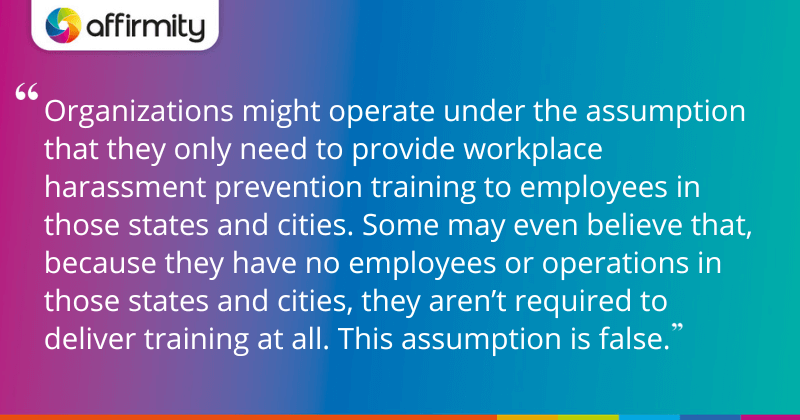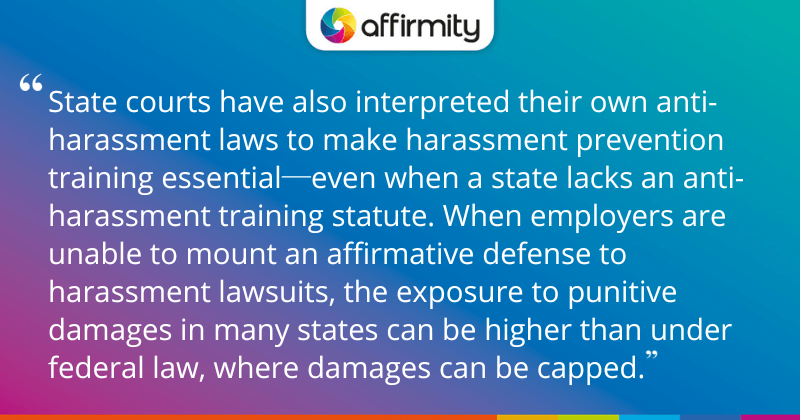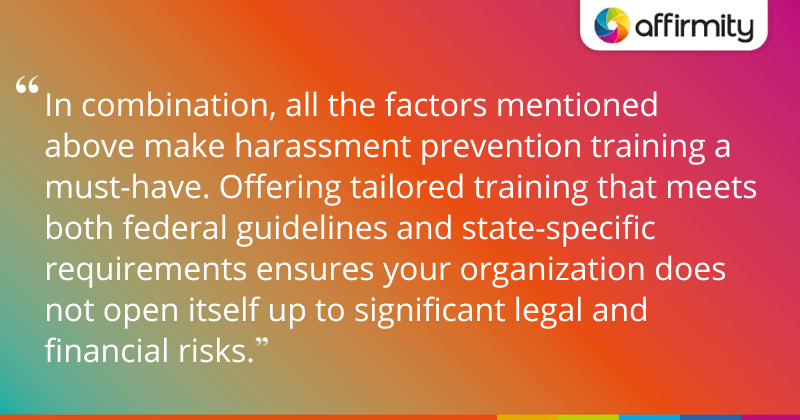Workplace harassment is a serious issue that can have devastating effects on employees and businesses alike. In this article, Vice President of Compliance Services at Traliant, Elissa Rossi examines some key differences at the state level and explains why EEOC guidance and court rulings make workplace harassment training compulsory for every organization.
Training to prevent harassment is not just a good idea, it’s a critical line of defense that protects your employees and shields your organization from liability. Despite this, many organizations have misconceptions about whether training is required across all 50 states.
The short answer is that employers in all 50 states need to provide harassment prevention training to all employees regularly.

A Common Misconception About Workplace Harassment Prevention Training
In total, eight US states have statutes requiring sexual harassment prevention training: California, Connecticut, Delaware, District of Columbia, Illinois, Maine, New York, and Washington. Additionally, two cities—Chicago and New York City—require training.
Organizations might operate under the assumption that they only need to provide workplace harassment prevention training to employees in those states and cities. Some may even believe that, because they have no employees or operations in those states and cities, they aren’t required to deliver training at all.
This assumption is false. The reality is that harassment prevention training is essential for all employees, wherever they are located, not just to comply with state and local requirements, but to protect your organization from lawsuits and ensure a safer workplace.

Why Harassment Prevention Training Is Required Everywhere
The real risk for employers isn’t a state regulator fining a company for noncompliance. It’s instead the risk of a harassment lawsuit and losing the ability to avoid punitive damages or raise an affirmative defense that could allow the employer to escape liability entirely.
For years, federal court decisions have shown that employers who do not train all employees may lose their ability to avoid punitive damages in a harassment lawsuit. In the Kolstad v. American Dental Association case, the US Supreme Court held that employers could avoid punitive damages if they could show that they had made “good faith efforts” to prevent harassment and discrimination. In determining “good faith efforts,” the Court held that, “the purposes underlying Title VII are… advanced where employers are encouraged to adopt anti-discrimination policies and to educate their personnel on Title VII’s prohibitions.”
To escape liability for hostile environment harassment by a supervisor, employers must show they took (1) reasonable care to prevent and correct promptly the harassing behavior; and (2) that the harassment victim unreasonably failed to complain. In the case of Faragher and Ellerth, the Court made clear that employers must:
- Have a clear anti-harassment policy with a clear process for reporting harassment concerns and provide training on it to all employees. It’s not enough for employers to have a harassment policy and hand it out to employees.
- Prove the complaining employee failed to use the employer’s complaint procedure or to take other steps to avoid or minimize harm from the harassment.
State courts have also interpreted their own anti-harassment laws to make harassment prevention training essential─even when a state lacks an anti-harassment training statute. For example, in Gaines v. Bellino, the New Jersey Supreme Court held that, in determining whether an employer is liable for co-worker harassment, the Court would examine factors such as whether the employer had provided anti-harassment training. According to the Court, the anti-harassment training “must be mandatory for supervisors and managers and must be available to all employees of the organization.”
When employers are unable to mount an affirmative defense to harassment lawsuits, the exposure to punitive damages in many states can be higher than under federal law, where damages can be capped.
EEOC Guidance on Nationwide Training
The Equal Employment Opportunity Commission (EEOC) has issued guidelines, which apply to employers in all states, stating that employers periodically “should provide [harassment prevention] training to all employees to ensure they understand their rights and responsibilities.” Further, the agency’s 2016 ‘Report from the Select Task Force on the Study of Harassment in the Workplace’ noted that “training should be conducted and reinforced on a regular basis for all employees.” The EEOC’s 2024 update to its ‘Enforcement Guidance on Harassment in the Workplace’ reaffirms that harassment prevention training should be ongoing, not a one-time event.
MORE ON THIS TOPIC | ‘6 EEOC Recommendations That Build Effective Sexual Harassment Prevention Training Programs’

State and City-Level Requirements
Certain states and cities have gone beyond federal law, enacting more specific requirements for how harassment prevention training should be conducted. This can include how often training must occur, what content should be included in the training, the minimum duration of training, and more. For example:
- California: A requirement that supervisors receive two hours of sexual harassment prevention training every two years has been in effect in California since 2005. In 2018, Senate Bill 1343 added an additional requirement for all employees to receive at least one hour of training every two years.
- Connecticut: The state requires that all employees—not just supervisors—receive two hours of workplace harassment prevention training within six months of their start date, and periodic supplemental training at least every ten years.
- Chicago: Since July 1, 2022, employers in Chicago have been required, on an annual basis, to provide two hours of sexual harassment prevention training to supervisors who manage Chicago employees, and one hour to Chicago employees. Additionally, all employees must receive one hour of bystander intervention training, focused on safe and positive actions that individuals or groups can take to prevent harm.
- Washington DC: Requires that employers of tipped wage workers must provide training to all employees within 90 days of hire and every two years. Within 30 days of training completion, an employer must submit certification of training to the DC Office of Human Rights.
In combination, all the factors mentioned above make harassment prevention training a must-have—firstly to reduce instances of workplace harassment, but also as an essential protective measure for organizations that would otherwise become liable when harassment occurs. Offering tailored training that meets both federal guidelines and state-specific requirements ensures your organization does not open itself up to significant legal and financial risks.
LEARN ABOUT KEY DIFFERENCES IN STATE-LEVEL PAY LAWS | ‘Your Guide to State-Level Pay Transparency Laws’
How Affirmity Can Help
Affirmity, in partnership with Traliant, offers a range of workplace harassment prevention courses that will help you cover the scenarios required across 50 states. We offer 45-minute (Fundamentals), one-hour (Extended), and two-hour (Advanced) courses, as well as supplementary Bystander Intervention Course required in the city of Chicago.
We have prepared a simple flowchart to help you identify which of our course versions you will need.
Courses covering the topic outside of the U.S. are also available.
For further help identifying the training courses your organization needs to remain compliant with workplace harassment prevention and other key laws, please contact us today.
About the Author
Elissa Rossi is Vice President of Compliance Services at Traliant. She has practiced employment law and litigation at various law firms, including Boyd Richards and Wilkie Farr. She also has served as an Assistant Attorney General in New York’s Attorney General’s Office. Elissa has represented clients in state and federal actions and in administrative proceedings before the EEOC and other regulatory bodies. Elissa is a graduate of the University of Pennsylvania and the University of Chicago Law School.
